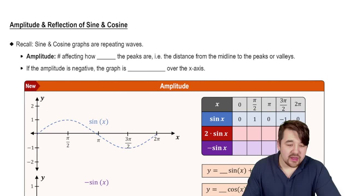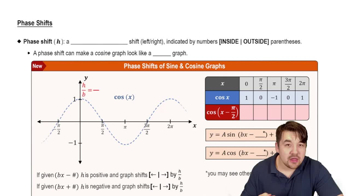Table of contents
- 0. Review of College Algebra4h 43m
- 1. Measuring Angles39m
- 2. Trigonometric Functions on Right Triangles2h 5m
- 3. Unit Circle1h 19m
- 4. Graphing Trigonometric Functions1h 19m
- 5. Inverse Trigonometric Functions and Basic Trigonometric Equations1h 41m
- 6. Trigonometric Identities and More Equations2h 34m
- 7. Non-Right Triangles1h 38m
- 8. Vectors2h 25m
- 9. Polar Equations2h 5m
- 10. Parametric Equations1h 6m
- 11. Graphing Complex Numbers1h 7m
4. Graphing Trigonometric Functions
Graphs of the Sine and Cosine Functions
Problem 29`
Textbook Question
In Exercises 17–30, determine the amplitude, period, and phase shift of each function. Then graph one period of the function. y = −2 sin(2πx + 4π)
 Verified step by step guidance
Verified step by step guidance1
Identify the standard form of the sine function: \( y = a \sin(bx + c) + d \).
Determine the amplitude by taking the absolute value of \( a \). Here, \( a = -2 \), so the amplitude is \( |a| = 2 \).
Calculate the period of the function using the formula \( \frac{2\pi}{b} \). In this case, \( b = 2\pi \), so the period is \( \frac{2\pi}{2\pi} = 1 \).
Find the phase shift by solving \( bx + c = 0 \) for \( x \). Here, \( 2\pi x + 4\pi = 0 \) gives \( x = -2 \). The phase shift is \( -2 \) units.
Graph one period of the function by starting at the phase shift \( x = -2 \) and using the amplitude and period to plot key points of the sine wave.
Recommended similar problem, with video answer:
 Verified Solution
Verified SolutionThis video solution was recommended by our tutors as helpful for the problem above
Video duration:
8mPlay a video:
Was this helpful?
Key Concepts
Here are the essential concepts you must grasp in order to answer the question correctly.
Amplitude
Amplitude refers to the maximum distance a wave reaches from its central axis or equilibrium position. In the context of sine functions, it is determined by the coefficient in front of the sine term. For the function y = -2 sin(2πx + 4π), the amplitude is 2, indicating that the wave oscillates 2 units above and below the central axis.
Recommended video:

Amplitude and Reflection of Sine and Cosine
Period
The period of a trigonometric function is the length of one complete cycle of the wave. It can be calculated using the formula 2π divided by the coefficient of x in the sine function. For the function y = -2 sin(2πx + 4π), the period is 1, meaning the function completes one full cycle over the interval of 1 unit along the x-axis.
Recommended video:

Period of Sine and Cosine Functions
Phase Shift
Phase shift refers to the horizontal displacement of a wave from its standard position. It is determined by the constant added to the x variable inside the sine function. In the function y = -2 sin(2πx + 4π), the phase shift can be calculated as -4π/(2π) = -2, indicating that the graph is shifted 2 units to the left along the x-axis.
Recommended video:

Phase Shifts

 5:53m
5:53mWatch next
Master Graph of Sine and Cosine Function with a bite sized video explanation from Nick Kaneko
Start learning